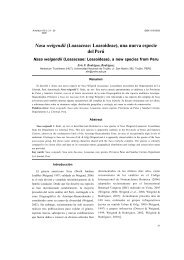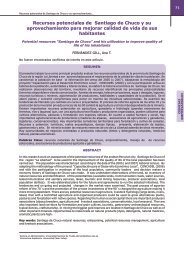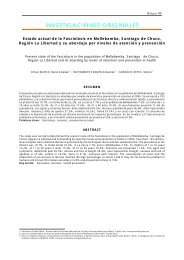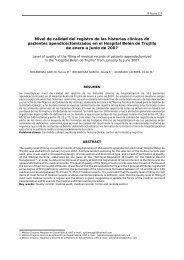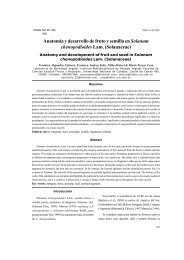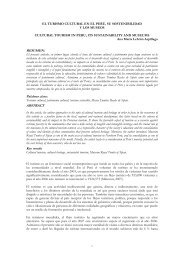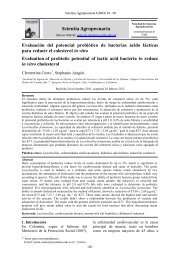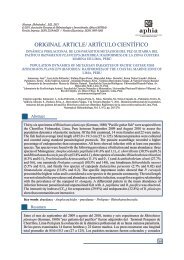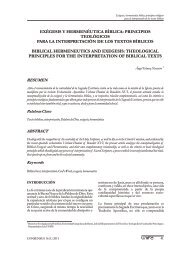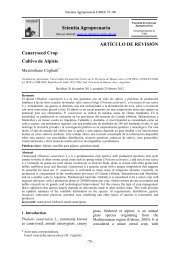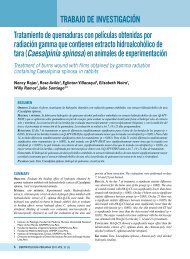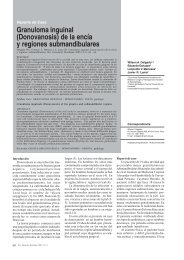neotropical vol. 6 - Portal del Sistema de Bibliotecas de la UNMSM
neotropical vol. 6 - Portal del Sistema de Bibliotecas de la UNMSM
neotropical vol. 6 - Portal del Sistema de Bibliotecas de la UNMSM
Create successful ePaper yourself
Turn your PDF publications into a flip-book with our unique Google optimized e-Paper software.
New host records of Prosthenhystera obesaMartins et al.Leporinus reinhardti and P. pohli are new hosts forP. obesa, Digenea with Neotropical distribution. Inaddition to these two hosts, P. obesa specimens hadpreviously been found in S. franciscanus (Brasil-Sato, 2002, 2003) and in P. macu<strong>la</strong>tus (Brasil-Sato2003, Brasil-Sato & Pavanelli 2004), both hostsfrom the upper São Francisco River. In S.franciscanus, seven P. obesa specimens werefound in five parasitized fish and only one of themwas parasitized by three P. obesa specimens in thegall b<strong>la</strong>d<strong>de</strong>r. Prevalence was 14% and its meanabundance 0.20 ± 0.52. Three P. obesa specimenswere collected from P. macu<strong>la</strong>tus – one specimenper host. Prevalence was 1.2% and meanabundance 0.01 ± 0.11. The morphometric data ofP. obesa are presented in Table 1.Table 1 lists the measurements of P. obesaspecimens in Characiformes, L. reinhardti (onespecimen), new host record, and S. franciscanus(three specimens) and in Siluriformes, P. pohli(one specimen), new host record, and P. macu<strong>la</strong>tus(three specimens) in the upper São FranciscoRiver.Leporinus reinhardti and P. pohli specimens werec<strong>la</strong>ssified as pregnant and immature, respectively.Seven mature specimens were collected from thegall b<strong>la</strong>d<strong>de</strong>r of S. franciscanus, five were pregnantand the three specimens collected from P.macu<strong>la</strong>tus were immature.DISCUSSIONThrough morphometric studies (Table 1),measurements of adult specimens (body lengthand width and oral sucker) found in L. reinhardtiwere lower than those shown by parasitespecimens of S. brevi<strong>de</strong>ns and S. maxillosus (= S.brasiliensis) (Kohn et al., 1997) but were simi<strong>la</strong>r tothose of S. brasiliensis (= S. franciscanus) (Brasil-Sato, 2002), and egg measurements were simi<strong>la</strong>r tothose of P. obesa eggs from S. maxillosus (= S.brasiliensis) (Kohn et al., 1997). Measurements ofbody length and width, oral sucker, acetabulumand pharynx of P. obesa from P. pohli were inferiorto those of immature specimens found in P.corruscans (Kohn et al., 1997). Measurements ofP. obesa in S. franciscanus were simi<strong>la</strong>r re<strong>la</strong>tive tothe other Characidae studied by Travassos (1922a)and Kohn et al. (1997). Measurements ofspecimens collected from P. macu<strong>la</strong>tus were <strong>la</strong>rgerthan those from Pimelodus spp. recor<strong>de</strong>d by Kohnet al. (1997) and in this study, they were a little<strong>la</strong>rger when compared to P. pohli. Besi<strong>de</strong>s theparameters of P. obesa in the São Francisco River,according to Isaac et al. (2000), prevalence of P.obesa in S. maxillosus was 14.3% and, according toBrasil-Sato & Pavanelli (2004), it was 3% in P.macu<strong>la</strong>tus from the Paraná River.The parasitic parameters were consi<strong>de</strong>red low,even though among the characiform hosts,predators of fish (ichthyophagi) both theprevalence and mean intensity were higher thanthose recor<strong>de</strong>d in the siluriform hosts in the basinsof the São Francisco River and the Paraná River.The highest prevalence (33.3%) of P. obesa wasrecor<strong>de</strong>d by Travassos (1940) in P. fur (oneparasitized host of three examined) and C.bimacu<strong>la</strong>tum (three hosts from nine examined),both fish from Salobra, Mato Grosso do Sul.According to Cribb et al. (2002), most digeneansoccurring in fish are <strong>de</strong>fined by the combination ofspecialized alimentary habits and the adoption ofspecialized colonization sites in their hosts.Campos et al. (2009) attribute the distribution ofhelminths to qualitative and/or quantitativechanges in the diet of the host. Leporinus reinhardtiis a foraging species of omnivorous alimentaryhabits, and analysis of stomach contents in fish inthis study showed that this species is opportunisticmaking use of resources that are avai<strong>la</strong>ble in itshabitat: the remains of vegetation, <strong>la</strong>rvae ofarthropods, crustaceans, insects and molluscs. Thepregnant specimen of P. obesa in the gall b<strong>la</strong>d<strong>de</strong>r ofL. reinhardti <strong>de</strong>monstrates its <strong>de</strong>finitive host.Pimelodus pohli is omnivore-carnivore and thepresence of arthropod <strong>la</strong>rvae and sediment wereobserved in its stomach content. This species couldalso act as a <strong>de</strong>finitive host, but due to the immaturespecimen found, it is not possible to state that.As the life cycle of Callodistomidae remains36



